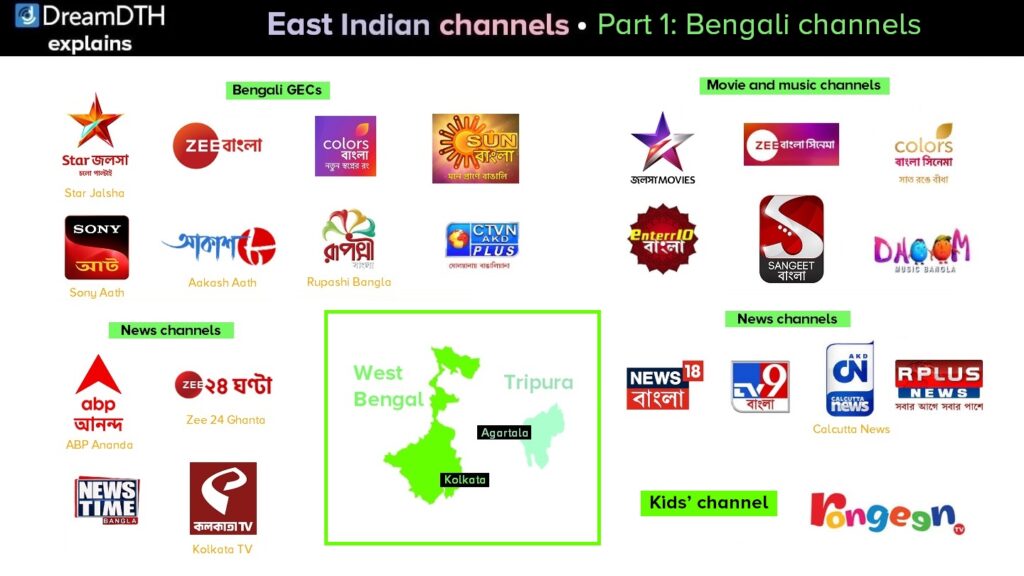With South Indian channels completed in our previous two explainer articles, we now turn to the TV landscape in East India, where Bengali has so far been the dominant language, but Odia is slowly catching up, while Assamese is driven entirely by local broadcasters — since national networks like Star and Zee are completely missing— and the heavily rural-focused Bhojpuri is powered almost entirely by DD Free Dish instead of pay-TV.
So much so that Bengali has benefited much more than the other three in terms of broadcaster budgets, and hence it is one of the ‘Big Six’ regional languages alongside the four South Indian languages (Tamil, Telugu, Kannada, Malayalam) and Marathi in the west — which also means that it has had HD channels for longer than the others, with Odia just starting out in the race, and Assamese and Bhojpuri completely staying out of the HD race due to lack of significant demand.
Note that while technically Bengali is the official language of both West Bengal and the northeastern state of Tripura, only the former accounts for most Bengali TV viewership, so only West Bengal is considered here. Moreover, Bengali is the only East Indian language with a large TV-viewing population outside the country, and hence the only one to have international feeds of its main GECs — but even this is very small compared to the diasporas of South Indian languages (except Kannada) as well as Punjabi.
For these reasons, much like the article on South Indian channels, this article is split into 2 parts: Part 1 focuses solely on Bengali channels — since there is much more to talk about them — and Part 2 on Odia, Assamese and Bhojpuri channels.
Big picture of TV channels in East Indian languages
Bengali and Odia: national broadcasters have had a longstanding presence
Zee, Star and Viacom18 are present in both the Bengali and Odia markets, but while Bengali is ruled by Star Jalsha — with Zee Bangla coming a close second — the largest Odia broadcaster is the local Ortel Communications, whose flagship channel Tarang TV leads the Odia market followed by Zee Sarthak, and Star Kiran has badly struggled since its launch in 2022. Viacom18’s Colors Bangla and Colors Odia have both been very unpopular, while Sony and Sun both have one Bengali channel each: Sony Aath was launched in 2009 (though it has a rather unconventional programming strategy, with dubbed serials and original animation shows instead of its own serials) and Sun Bangla in 2019. In fact, Sony Aath is one of only two Sony regional channels before its merger with Zee — Sony Marathi (launched in 2018) being the other — not counting Sony Sports Ten 4 which is a Tamil/Telugu channel.
While Bengali has multiple movie channels (Jalsha Movies, Zee Bangla Cinema, Colors Bangla Cinema, etc.) and music channels (Sangeet Bangla, Dhoom Music, etc.), Odia has had to make do with only Ortel’s channels — Alankar TV (movies) and Tarang Music — in these genres. However, since Odisha is home to the renowned Puri Jagannath temple, Odia has three Hindu devotional channels — Prarthana TV from Ortel, and two from the Sidharth network, Sidharth Bhakti and Jay Jagannath — whereas Bengali has none, even though West Bengal also has important Hindu temples like the Dakshineshwar Kali Mandir.
In terms of news channels, the ABP publishing group is the largest Bengali-language media house by a large distance — much like Malayala Manorama in Kerala — and it operates a nationwide news network across multiple states, with ABP Ananda being its Bengali channel. ABP Ananda and its siblings ABP News (Hindi) and ABP Majha (Marathi) were originally a joint venture with Star and used the Star brand before ABP acquired them completely in 2012 and they switched to the ABP brand. Later, ABP Asmita (Gujarati), ABP Sanjha (Punjabi) and ABP Ganga (Uttar Pradesh) were launched, but the latter two ceased satellite broadcasting in 2023 and switched to a digital-only presence.
Zee and News18 are also present in West Bengal (Zee 24 Ghanta and News18 Bangla) and Odisha (Zee Odisha News — which is digital-only — and News18 Odia). Zee discontinued its satellite Zee Odisha channel in 2022 and replaced it with the digital-only Zee Odisha News. Another national news network, TV9, launched its Bengali channel TV9 Bangla before the state assembly elections in 2021, while Arnab Goswami’s Republic TV launched Republic Bangla at the same time. This aside, there are numerous local news channels like News Time Bangla, Kolkata TV, Calcutta News and R Plus News in Bengali, and Naxatra News, MBC TV, Kanak News, Kamyab TV, Argus News and Bada Khabar in Odia.
Assamese: only local broadcasters
In contrast, Assamese television is dominated by local broadcasters, since the major national networks have completely avoided Assam (except News18 Assam/Northeast), which meant it has missed out on the growth and capital infusion that Bengali has enjoyed. It goes without saying that no Assamese channel broadcasts in 16:9 aspect ratio, let alone HD. Even so, there are a large number of Assamese channels, whereas other Northeastern states have almost nothing apart from Doordarshan channels. Three local companies control the Assamese TV landscape:
- Pride East Entertainment, whose flagship GEC, Rang TV, is the largest in Assam and also operates News Live, North East Live (an English and Hindi news channel), Ramdhenu (music) and Indradhanu (movies);
- AM Television, which operates the GEC Rengoni TV and Prag News; and
- Brahmaputra Tele Productions, which has the GEC Jonack and the news channel DY 365.
Despite the lack of national broadcasters among GECs, it has a large number of news channels, also including Pratidin Time, Pratham Khabar (formerly News Time Assam) and Assam Talks — though national news networks do have News18 Assam/Northeast and the upcoming Zee 24 Ghanta Northeast. More recently, a number of Assamese news channels have been launched since 2021: DA News Plus, News Daily 24 (ND24), NB News and NKTV 24×7 (not to be confused with the national English news channel NDTV 24×7!). Of these, NKTV 24×7 is most noteworthy in that it launched an Assamese GEC, Spondon, in late 2022, and then expanded to Bengali with the NKTV Bangla news channel in 2023.
Bhojpuri: almost entirely rural and powered by DD Free Dish
In sharp contrast to all other Indian regional languages, which usually have more pay than free channels, Bhojpuri channels are predominantly rural-focused and overwhelmingly driven by DD Free Dish, and so all Bhojpuri channels must be present on the platform or risk losing viewership. Among major national broadcasters, Zee is the only one with a presence in the Bhojpuri market, in the form of GEC Zee Ganga (formerly Big Ganga) and movie channel Zee Biskope. In fact Zee Ganga is the only Bhojpuri GEC currently on air, as others like Dishum and Enterr10 Rangeela have shut down, and most Bhojpuri channels are movie channels from small free-to-air networks: from Enterr10’s Bhojpuri Cinema to Sri Adhikari Brothers (SABGroup)’s Dabangg to IN10 Media’s Filamchi Bhojpuri to MH One’s MH One Dil Se, as well as the independent Oscar Movies Bhojpuri. The only other Bhojpuri channel is Sangeet Bhojpuri by Media Worldwide Pvt. Ltd., which also operates Sangeet-branded music channels in Bengali and Marathi — as well as Music India in Hindi — and there are no Bhojpuri news channels.
Now we start with Bengali channels, where the Star and Zee networks dominate among GECs and movie channels — especially given Star Jalsha’s big contribution to Disney Star’s other regional channels’ success in the form of serials that are remade in other languages — and ABP (Bengal’s largest publishing group for over a century) has had a strong presence in news broadcasting for over two decades, both within West Bengal and nationally. The next instalment covers Odia, Assamese and Bhojpuri channels since they have comparatively less to talk about.









2 replies
Loading new replies...
Join the full discussion at the DreamDTH Forums →